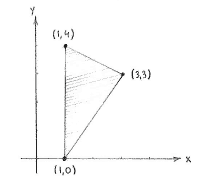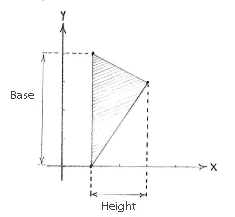Lösung 2.2:9a
Aus Online Mathematik Brückenkurs 1
(Unterschied zwischen Versionen)
K (hat „Solution 2.2:9a“ nach „Lösung 2.2:9a“ verschoben: Robot: moved page) |
|||
| Zeile 1: | Zeile 1: | ||
| - | + | Wir beginne damit, die Punkte (1,4), (3,3) and (1,0), sodass wir sehen wie das Dreieck aussieht. | |
| - | + | ||
[[Image:2_2_9_a-1(2).gif|center]] | [[Image:2_2_9_a-1(2).gif|center]] | ||
| + | Die Fläche eines Dreiecks ist | ||
| - | + | {{Abgesetzte Formel||<math>\text{Fläche} = \frac{1}{2}\cdot\text{(Basis)}\cdot\text{(Höhe),}</math>}} | |
| - | + | ||
| - | {{Abgesetzte Formel||<math>\text{ | + | |
| - | + | Nachdem die Kante zwischen den Punkten (1,0) und (1,4) parallel mit der ''y''-Achse ist, bezeichnen wir diese Kante als Basis. Die Basis des Dreiecks ist der Unterschied zwischen den ''y''-Koordinaten von den Punkten (1,0) und (1,4) | |
{{Abgesetzte Formel||<math>\text{base} = 4-0 = 4\,\textrm{.}</math>}} | {{Abgesetzte Formel||<math>\text{base} = 4-0 = 4\,\textrm{.}</math>}} | ||
| - | + | Die Höhe des Dreiecks ist der Unterschied zwischen den ''x''-Koordinaten zwischen den Punkt (3,3), und der Gerade <math>x=1</math> | |
{{Abgesetzte Formel||<math>\text{height} = 3-1 = 2\,\textrm{.}</math>}} | {{Abgesetzte Formel||<math>\text{height} = 3-1 = 2\,\textrm{.}</math>}} | ||
| Zeile 21: | Zeile 19: | ||
| - | + | Also ist die Fläche des Dreiecks | |
{{Abgesetzte Formel||<math>\text{Area} = \tfrac{1}{2}\cdot\textrm{(base)}\cdot\textrm{(height)} = \tfrac{1}{2}\cdot 4\cdot 2 = 4\,\text{u.a.}</math>}} | {{Abgesetzte Formel||<math>\text{Area} = \tfrac{1}{2}\cdot\textrm{(base)}\cdot\textrm{(height)} = \tfrac{1}{2}\cdot 4\cdot 2 = 4\,\text{u.a.}</math>}} | ||
Version vom 12:59, 13. Mär. 2009
Wir beginne damit, die Punkte (1,4), (3,3) and (1,0), sodass wir sehen wie das Dreieck aussieht.
Die Fläche eines Dreiecks ist
| \displaystyle \text{Fläche} = \frac{1}{2}\cdot\text{(Basis)}\cdot\text{(Höhe),} |
Nachdem die Kante zwischen den Punkten (1,0) und (1,4) parallel mit der y-Achse ist, bezeichnen wir diese Kante als Basis. Die Basis des Dreiecks ist der Unterschied zwischen den y-Koordinaten von den Punkten (1,0) und (1,4)
| \displaystyle \text{base} = 4-0 = 4\,\textrm{.} |
Die Höhe des Dreiecks ist der Unterschied zwischen den x-Koordinaten zwischen den Punkt (3,3), und der Gerade \displaystyle x=1
| \displaystyle \text{height} = 3-1 = 2\,\textrm{.} |
Also ist die Fläche des Dreiecks
| \displaystyle \text{Area} = \tfrac{1}{2}\cdot\textrm{(base)}\cdot\textrm{(height)} = \tfrac{1}{2}\cdot 4\cdot 2 = 4\,\text{u.a.} |


